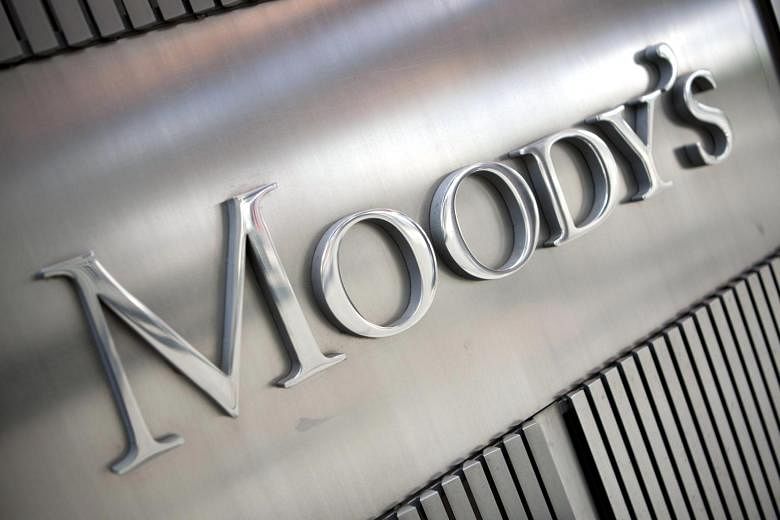SYDNEY (BLOOMBERG) - The decision by Moody's Investors Service to downgrade the ratings of Australia's largest banks has focused attention on the risks lurking in the country's A$1.51 trillion (S$1.59 trillion) of mortgage loans.
"The resilience of household balance sheets and, consequently, bank portfolios to a serious economic downturn has not been tested at these levels of private sector indebtedness," Moody's said in the statement accompanying the downgrade of Australia & New Zealand Banking Group, Commonwealth Bank of Australia, National Australia Bank and Westpac Banking.
The banks are already bracing themselves for an announcement in the coming days from the Australian Prudential Regulatory Authority (Apra), which is due to say whether it will require the banks to hold more capital against their mortgage books as part of a wider update on capital requirements. Despite recent steps to rein in their exposure to riskier mortgages, the lenders still sit on by far the largest property lending books of any banks in the world, measured as a proportion of total loans.
More than 60 per cent of the Australian banking system's loan book is in residential property, nearly 20 percentage points more than second-placed Norway and more than double the US ratio, according to data from the International Monetary Fund. In Hong Kong's frothy housing market, the ratio stands at only 14 per cent.
The exposure to housing reflects the lack of other lending opportunities for Australian banks, and the large profits they have made from home loans, according to TS Lim, head of research at Bell Potter Securities Ltd. "In Australia there are very few sectors apart from resources and mortgages - and the former has also shrunk since the financial crisis," Lim said by email.
In the words of Apra Chairman Wayne Byres: "If we are going to put an increasing number of eggs into a single basket, we'd better make sure that basket is an unquestionably strong one." Byres made the comment in April, noting in the same speech that the regulator is reviewing "the relative and absolute capital requirements for housing exposures".
One key measure of how banks have reduced risks in their mortgage books is the recent shift away from loans to investment properties, which Apra said in March should not exceed 30 per cent of new home loans. As more Australians tried to ride the housing boom by buying second, third (and fourth) homes, the proportion of new loans issued to investors jumped to 45 per cent of the total in the second quarter of 2015. It has since fallen back to about 35 per cent, but remains above Apra's ceiling.
"Growth in housing debt had outpaced the slow growth in household incomes," minutes from the Reserve Bank of Australia's (RBA) June 6 meeting showed on Tuesday. "Apra's recent prudential supervision measures should help address the risks associated with high and rising levels of indebtedness."
Australian banks are prepared to lend a greater proportion of a borrower's income than many overseas peers. Half of Australia's mortgage credit is held by households who have borrowed more than six times their annual income, according to research by JCP Investment Partners, an equities fund. In the UK, banks are allowed to issue only 15 per cent of new mortgages at more than 4.5 times borrowers' income.
Household debt is already at 189 per cent of annual household income - one of the highest levels in the world. The RBA recently estimated that one-third of borrowers have little or no buffer in the form of money set aside to meet an unexpected rise in mortgage loan repayments or other costs.
"For a while now we have been concerned because of low interest rates and the growth of property prices that people are getting in over their heads," Australian Securities & Investments Commission Chairman Greg Medcraft told reporters on Tuesday. "You've got to think interest rates won't stay where they are forever." Australian banks were also more aggressive than banks in the UK and the US in terms of the maximum size of mortgages they were prepared to offer relative to income according to the results of a recent "mystery-shopper" exercise conducted by analysts at Macquarie Group. Despite that, the proportion dropped slightly when compared with a similar survey in 2016.
Interest-only mortgages - typically used by investment buyers - make up a large and growing proportion of the banks' loan books. They have become a way for some home buyers to take on loans they might not otherwise have been able to afford, as property values have risen, Matthew Wilson, head of financials research at Melbourne-based equities fund JCP said in May. "Interest-only could be Australia's subprime," Wilson said.
The proportion of the highest loan-to-value mortgages has been steadily decreasing as the major banks have toughened up on loans to buyers seeking to borrow for more than 90 per cent of the value of their home. However, soaring house prices and stagnant wage growth mean that most new business is still being written in the 60 to 80 per cent loan-to-value range.
"Wages growth has been very muted, property prices - Sydney is eight times income - people need to really think about that," ASIC's Medcraft said.
Add in the headwinds to the sector from the new banking levy and lacklustre overall economic growth, the market is turning more bearish on the banks. The ASX 200 Banks Index is down 10 per cent from its May peak. "We continue to find it difficult to be bullish the banks in this environment," UBS Group AG analyst Jon Mott, who has no buy ratings on any Australian banks, wrote in a recent note.

